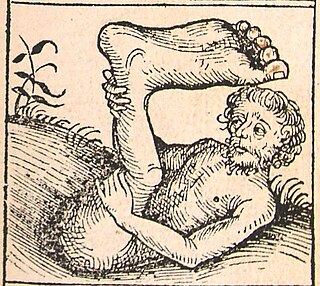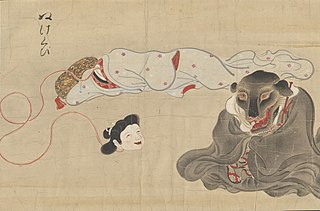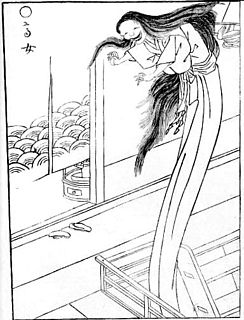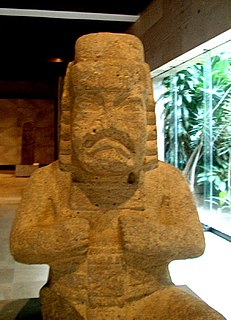 W
WAbarimon or antipode in mythology are people whose feet are turned backwards, but in spite of this handicap were able to run at great speed.
 W
WThe Badalisc is a mythical creature of the Val Camonica, Italy, in the southern central Alps. The Badalisc is represented today as a creature with a big head covered with a goat skin, two small horns, a huge mouth and glowing eyes.
 W
WEnkidu (𒂗𒆠𒄭 EN.KI.DU10), was a legendary figure in ancient Mesopotamian mythology, wartime comrade and friend of king Gilgamesh. Their exploits were composed in Sumerian poems and in the Akkadian Epic of Gilgamesh, written during the 2nd millennium BC. He is the oldest literary representation of the wild man, a recurrent motif in artistic representations in Mesopotamia and in Ancient Near East literature. The apparition of Enkidu as a primitive man seems to be an innovation of the Old Babylonian version (1300 - 1000 BC), as he was originally a servant-warrior in the Sumerian poems.
 W
WThe Erlking is a sinister, mythical elf who is said to linger in the woods. He goes around and kills children who stay in the woods too long, and kills them by a single touch. The name "Erlking" is a name used in German Romanticism for the figure of a spirit or "king of the fairies". It is usually assumed that the name is a derivation from the ellekonge in Danish folklore. The name is first used by Johann Gottfried Herder in his ballad "Erlkönigs Tochter" (1778), an adaptation of the Danish Hr. Oluf han rider (1739), and was taken up by Johann Wolfgang von Goethe in his poem "Erlkönig" (1782), which was set in music by Schubert, among others. In English translations of Goethe's poem, the name is sometimes rendered as Erl-king.
 W
WIn Greek mythology, a Gorgon is a mythical creature portrayed in ancient literature. While descriptions of Gorgons vary and occur in the earliest examples of Greek literature, the term commonly refers to any of three sisters who had hair made of living, venomous snakes, as well as a horrifying visage that turned those who beheld her to stone.
 W
WGurumāpā is a mythical creature in the folklore of Nepal Mandala. According to legend, he is said to take away disobedient children, and so was banished to a field in Kathmandu.
 W
WVarious species of mythical headless men were rumoured, in antiquity and later, to inhabit remote parts of the world. They are variously known as akephaloi or Blemmyes and described as lacking a head, with their facial features on their chest. These were at first described as inhabitants of ancient Libya or the Nile system (Aethiopia). Later traditions confined their habitat to a particular island in the Brison(e) River, or shifted it to India.
 W
WHitotsume-kozō (一つ目小僧) are a Yōkai of Japan that take on the appearance of a bald-headed child with one eye in the center of its forehead similar to a cyclops.
 W
WA hulder is a seductive forest creature found in Scandinavian folklore. Her name derives from a root meaning "covered" or "secret". In Norwegian folklore, she is known as huldra. She is known as the skogsrå "forest spirit" or Tallemaja "pine tree Mary" in Swedish folklore, and ulda in Sámi folklore. Her name suggests that she is originally the same being as the völva divine figure Huld and the German Holda.
 W
WThe terms human–animal hybrid and animal–human hybrid refer to an entity that incorporates elements from both humans and animals.
 W
WIn the Chilote folklore and Chilote mythology of the Chiloé Island in southern Chile, the imbunche is a legendary monster that protects the entrance to a warlock's cave.
 W
WIn Philippine folklore, the kapre is a creature that could be characterized as a tree giant. It is described as being a tall, big, black, terrifying, hairy, muscular creature. Kapres are normally described as having a strong smell that attracts human attention. They stay at a branch of a tree smoking.
 W
WThe Karzełek or Skarbnik, Kladenets or Dzedka in Slavic mythology live in mines and underground workings and are the guardians of gems, crystals, and precious metals. It is said that they will protect miners from danger and lead them back when they are lost. They will also lead them to veins of ore. To people who are evil or insult them they are deadly, pushing them into dark chasms or send tunnels crashing down upon them. Hurling rocks, whistling, or covering one's head are actions that are offensive to Skarbnik, who will warn the offender with handfuls of pelted soil in their direction before taking serious action.
 W
WKhyāh (ख्याक) is a mythical humanoid creature in Nepalese folklore. It is depicted as a fat, hairy and short ape-like creature.
 W
WLittle people have been part of the folklore of many cultures in human history, including Ireland, Greece, the Philippines, the Hawaiian Islands, New Zealand, Flores Island, Indonesia, and Native Americans.
 W
WThe Mistress of the Copper Mountain, also known as The Malachite Maid, is a legendary creature from Slavic mythology and a Russian fairy tale character, the mountain spirit from the legends of the Ural miners and the Mistress of the Ural Mountains of Russia. In the national folktales and legends, she is depicted as an extremely beautiful green-eyed young woman in a malachite gown or as a lizard with a crown. She has been viewed as the patroness of miners, the protector and owner of hidden underground riches, the one who can either permit or prevent the mining of stones and metals in certain places.
 W
WMonopods are mythological dwarf-like creatures with a single, large foot extending from a leg centered in the middle of their bodies. The names monopod and skiapod (σκιάποδες) are both Greek, respectively meaning "one-foot" and "shadow-foot".
 W
WThe Noppera-bō (のっぺらぼう), or faceless ghost, is a Japanese yōkai that looks like a human but has no face. They are sometimes mistakenly referred to as a mujina, an old Japanese word for a badger or raccoon dog. Although the mujina can assume the form of the other, noppera-bō are usually disguised as humans. Such creatures were thought to sometimes transform themselves into noppera-bō in order to frighten humans. Lafcadio Hearn used the animals' name as the title of his story about faceless monsters, probably resulting in the misused terminology.
 W
WRokurokubi is a type of Japanese yōkai (apparition). They look almost completely like humans with one of two differences. There is a type whose neck stretches and another whose head detaches and flies around freely (nukekubi). The Rokurokubi appear in classical kaidan and in yōkai works. It has been suggested, however, that the idea of rokurokubi may have been created purely for entertainment purposes rather than originating from any folk beliefs or legends.
 W
WNure-onna is a Japanese yōkai which resembles a reptilious creature with the head of a woman and the body of a snake. They are also known to be a paranormal phenomenon at sea under the name of nureyomejo. In legends, they are often said to consume humans, but they have no single appearance or personality.
 W
WAn ogre is a legendary monster usually depicted as a large, hideous, man-like being that eats ordinary human beings, especially infants and children. Ogres frequently feature in mythology, folklore, and fiction throughout the world. They appear in many classic works of literature, and are most often associated in fairy tales and legend with a taste for infants.
 W
WThe Pombéro, known also as Pomberito, Pÿragué, Karaí Pyhare, Kuarahy Jára is from Paraguay but also in the mythology of the mbyá tribe of southern Brazil and the Argentinian province of (Misiones) and Cho Pombé is a mythical humanoid creature of small stature in Guaraní mythology. The legend, along with those of other mythological figures of the Guaraní, is an important part of the culture of a region stretching from northeast Argentina northward through the whole of Paraguay and into southern Brazil.
 W
WRokurokubi is a type of Japanese yōkai (apparition). They look almost completely like humans with one of two differences. There is a type whose neck stretches and another whose head detaches and flies around freely (nukekubi). The Rokurokubi appear in classical kaidan and in yōkai works. It has been suggested, however, that the idea of rokurokubi may have been created purely for entertainment purposes rather than originating from any folk beliefs or legends.
 W
WSaci is a character in Brazilian folklore. He is a one-legged black or mulatto youngster, who smokes a pipe and wears a magical red cap that enables him to disappear and reappear wherever he wishes. Considered an annoying prankster in most parts of Brazil, and a potentially dangerous and malicious creature in others, he nevertheless grants wishes to anyone who manages to trap him or steal his magic cap. However, his cap is often depicted as having a bad smell. Most people who claimed to have stolen this cap say they can never wash the smell away.
 W
WIn the folklore of the Sami, a Stallo is a large, human-like creature who likes to eat people and who therefore is usually in some form of hostilities with a human. Stallos are clumsy and stupid, and thus humans often gain the upper hand over them.
 W
WTakaonna was a Japanese yōkai that appeared in the Gazu Hyakki Yagyō by Toriyama Sekien.
 W
WIn the traditional Chilota mythology of Chiloé, the Trauco is a humanoid creature of small stature - similar to a dwarf or goblin - who lives in the deep forests. It has an ugly face, and legs without feet.
 W
WA troll is a being in Scandinavian folklore, including Norse mythology. In Old Norse sources, beings described as trolls dwell in isolated rocks, mountains, or caves, live together in small family units, and are rarely helpful to human beings.
 W
WThe were-jaguar was both an Olmec motif and a supernatural entity, perhaps a deity.
 W
WIn folklore, a werewolf, or occasionally lycanthrope, is a human with the ability to shapeshift into a wolf, either purposely or after being placed under a curse or affliction with the transformations occurring on the night of a full moon. Early sources for belief in this ability or affliction, called lycanthropy, are Petronius (27–66) and Gervase of Tilbury (1150–1228).
 W
WThe wild man is a mythical figure that appears in the artwork and literature of medieval Europe, comparable to the satyr or faun type in classical mythology and to Silvanus, the Roman god of the woodlands.
 W
WYamauba , Yamamba or Yamanba are variations on the name of a yōkai found in Japanese folklore.
 W
WYuki-onna is a spirit or yōkai in Japanese folklore that is often depicted in Japanese literature, films, or animation.
 W
WYuki-onna is a spirit or yōkai in Japanese folklore that is often depicted in Japanese literature, films, or animation.